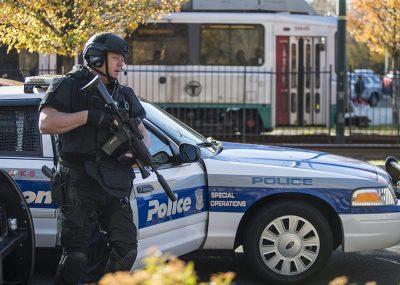
As mass shootings in the United States have become increasingly prevalent in recent years, the issues of gun safety and active shooter attack preparedness at Boston University have come to the forefront of the community’s concerns.
Despite the fact that BU prohibits guns on campus, guns are allowed in the city of Boston, and BU is an open campus. If someone wanted to bring a gun onto campus, it would be possible, according to Kelly Nee, chief of the BU Police Department.
Nee said the BUPD holds annual active shooter drills, but any additional drills are not mandated. However, the BUPD will hold extra drills with students and faculty of any on-campus building, including dorms, if asked.
“It is important for us to get more aggressive in making sure all the deans and faculty — anyone who’s interested — know that we have this capability,” Nee said. “If they want it for their building, we’re more than happy to do it.”
Nee said she doesn’t know why the drills are not mandatory at BU, but that the size and age of the student population is likely a factor.
An active shooter drill with students would typically have two parts. First, BUPD officers would highlight areas of a building that could be used for escape or hiding. The second part would be a live drill where officers use Simunition ammunition — nonlethal ammunition designed for training exercises — to provide an opportunity for participants to use the information taught in the first part under a semi-realistic setting.
Lindsey Wilcox, a junior in the Sargent College of Health and Rehabilitation Sciences, said she had not heard of student training before, but would potentially be interested.
“I think students may not be super prepared,” Wilcox said. “I can only hope that the facilities are more prepared.”
The most recent drill was held at the Fitness and Recreation Center on Jan. 10, said BU spokesman Colin Riley. The drill involved BUPD officers, Boston Police officers, Brookline Police officers, FitRec staff, student workers and an Armstrong ambulance.
Other drills have included scenarios where the situation begins at the medical campus and migrates to the Charles River campus. However, Riley added that there is no way to drill the entire campus due to its size.
College of Arts and Sciences junior Colin Chiakpo said he would be interested in participating in a drill, but that he thinks it is more important to focus on changing American gun access laws so that drills are no longer necessary.
Chiakpo said he is concerned about the safety of BU’s residential buildings, especially considering their large populations and that security personnel are not armed.
“BU might not necessarily be at risk, but if the situation occurred, I think the death toll at BU would be very high,” Chiakpo said.
Riley said that even though BUPD responds to an on-campus call within two minutes, it is important for students to know what to do. He suggested students look at BUPD’s web pages on responding to an active shooter situation.
“Run, hide, fight,” a defense technique endorsed by the U.S. Department of Homeland Security, are the key terms students should be aware of in order to know how to respond in a life-threatening shooter situation, Riley said.
Nee said the technique, which many U.S. high schools teach, is the soundest message, but that people also have to be aware of their surroundings and be able to think for themselves should they find themselves in an active shooter situation.
“The situation in an active shooter situation is that the first person responsible for your safety is yourself,” Riley said.
In the School of Public Health, an initiative called “#Enough” is working to get people, especially lawmakers, to view firearm violence as a public health issue instead of as a criminal problem.
“Declaring that this is a public health problem would mean declaring that we are not going to accept this level of violence in our society,” said Michael Siegel , a firearms researcher and community health sciences professor.
Classifying firearm violence as a public health problem would mean that the role of society and the United States’ gun culture could also be examined, Siegel said. It could also break through governmental disinterest in funding firearms research.
Siegel said his research showed a correlation in all 50 states between high availability of guns, high rates of household gun ownership and high rates of suicide and homicide. He said these rates were lower in states that had stricter gun access laws.
But not everyone is convinced that public health is the way to get the government’s attention.
Avery Hellen, a freshman in the College of Engineering, said he thinks criminology is a more powerful lens through which one may view the issue of firearm violence.
“People are kind of notorious for not really taking [public health issues] seriously and just doing what they want,” Hellen said.
For Wilcox, legislation changes of the kind that Siegel’s research promotes are the only real solution for preventing a continued increase in active shooter situations.
“I think it’s very easily preventable if our government gets their butts in gear and actually passes some legislation,” Wilcox said. “Until that happens, I can’t foresee anything getting better.”























































































































